Charts of the Week
Charts of the week from 13 to 17 February 2022: gross domestic product, current account of the balance of payments, activity in construction, number of persons in employment and other charts
In the last quarter of last year, year-on-year GDP growth slowed significantly (to 0.2%), while in 2022 as a whole GDP increased by 5.4%. Towards the end of the year, the situation deteriorated, especially in the export-oriented part of the economy. The strong growth in 2022 as a whole was mainly supported by strong investment activity and private consumption, which already weakened towards the end of the year. Investment activity was relatively strong especially in construction, with building construction standing out compared to previous years. Civil engineering activity was also high. The growth of imports exceeded the growth of exports, which contributed to a negative external trade balance. After 10 years of surplus, the current account turned into a deficit last year. Amid strong domestic demand and deteriorated terms of trade, the goods trade balance was the main contributor to the significant decline in the balance. The number of persons in employment reached a peak last year and was 2.4% higher than in 2021. Employment growth was primarily due to the employment of foreign citizens, with particularly high shares in construction, transportation and storage, and administrative and support service activities. In the first half of February, when temperatures were low, gas consumption was only about one percent lower than in previous years. From August to November, consumption in Slovenia and in the EU as a whole fell (by almost 15% and by one-fifth respectively) compared to the previous five-year period, due not only to favourable weather conditions but also to measures to reduce gas consumption and adjustments in industry. Electricity consumption was lower in January in all consumption groups, most markedly in industry.
Gross domestic product, Q4 2022
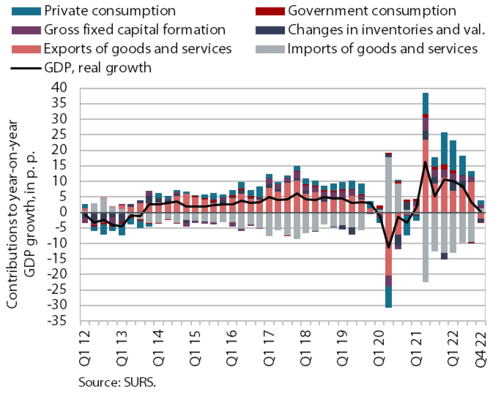
After a sharp decline in the third quarter, GDP grew by 0.8% in current terms in the fourth quarter of last year; year-on-year growth weakened significantly (to 0.2%). In 2022 as a whole, GDP grew by 5.4%. The situation deteriorated towards the end of the year, especially in the export-oriented part of the economy. Value added in manufacturing was lower in the fourth quarter than a year earlier, especially in energy-intensive industries, and merchandise exports was also lower year-on-year. Growth in services exports, driven since spring mainly by the post-COVID-19 recovery in tourism, also slowed. In 2022 as a whole, the import growth exceeded export growth, contributing to a negative external trade balance. Investment activity remained relatively strong also in the last quarter amid high construction activity. After consumer confidence began to decline in the spring in the context of uncertainty regarding the energy and food crises and the loss of purchasing power, household spending weakened by the end of the year, while growth remained high compared to the previous year. Similar to the third quarter, government consumption in the fourth quarter was also lower than a year ago, mainly due to significantly lower expenditure on containment measures.
Current account of the balance of payments, December 2022
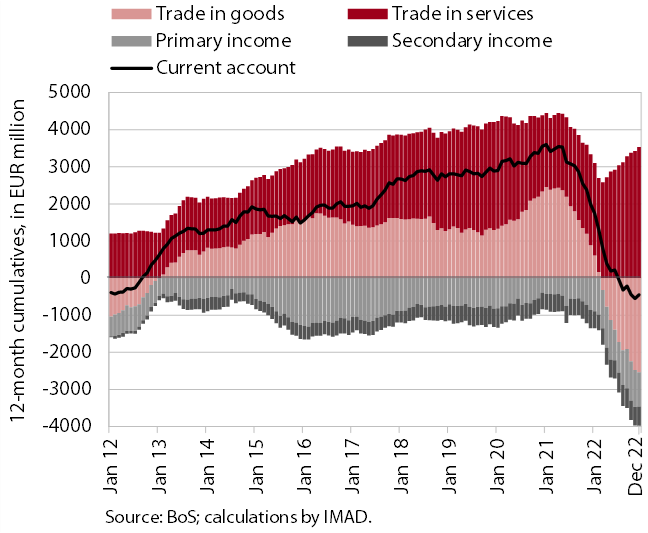
For the first time in ten years, the current account surplus turned into a deficit in 2022 (EUR 449.6 million or 0.8% of GDP). Amid strong domestic demand and deteriorated terms of trade, the goods trade balance was the main contributor to the significant decline in the current account balance. The services surplus increased and was higher in all segments of trade in services, especially in travel services, as receipts from foreign tourists who visited Slovenia increased much more (by EUR 1.2 billion) than expenditure of Slovenian tourists abroad (by EUR 0.5 billion). Net outflows of primary and secondary income were higher than a year ago. The primary income deficit was higher mainly because more customs duties were paid into the EU budget (import of electric vehicles for the EU market via the port of Koper), while subsidies received from the EU budget were also lower. The higher secondary income deficit arose from higher government and private sector transfers abroad. From the perspective of savings/investment gap, the decline in the current account balance was mainly due to lower gross saving, especially by households, while investment activity also picked up.
Activity in construction, December 2022
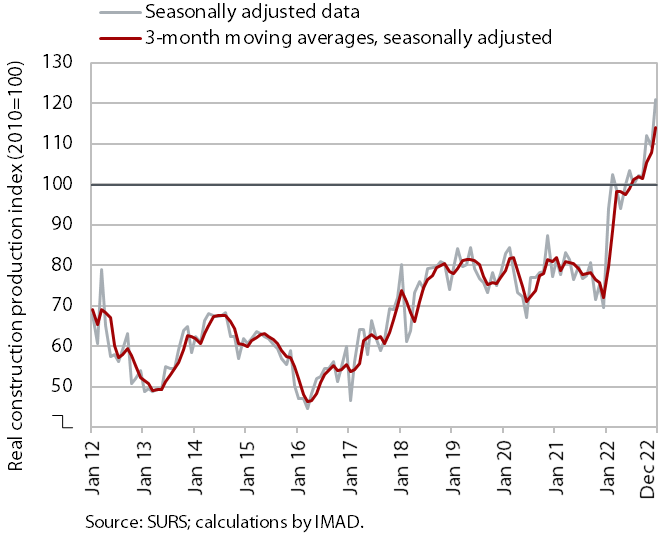
According to figures on the value of construction put in place, construction activity in December 2022 was considerably higher than in the same month of 2021. After a strong upswing at the beginning of 2022, the value of construction work remained roughly unchanged, before increasing towards the end of the year. In December, it was 74% higher than in December 2021. Compared to previous years, construction of buildings stands out in terms of the level of activity. Activity was also high in civil engineering, while it was lower in specialised construction work (installation works and building completion).
However, some other data suggest significantly lower construction activity. According to VAT data, the activity of construction companies in December 2022 was 6% higher than in December 2021. Based on data on the value of construction put in place, the difference in the growth was 68 p.p. Data on the value of industrial production in two activities traditionally strongly linked to construction also do not point to such high growth. Production in other mining and quarrying was 1% lower in December 2022 than in the same month of 2021, while it was 8% lower in the manufacture of other non-metallic mineral products.
Number of persons in employment, December 2022
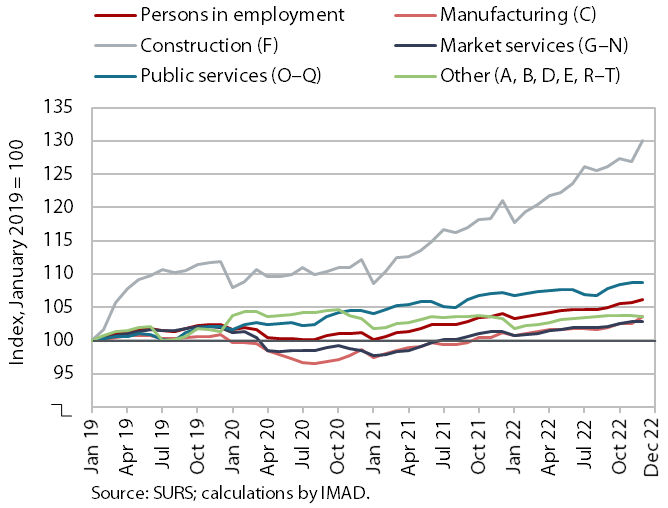
In December 2022, year-on-year growth in the number of persons in employment was 2%, similar as in the previous months. It was strongest in construction, which is facing a major labour shortage and where the number of persons in employment increased the most compared to the beginning of 2019. Employment of foreign workers has been the largest contributor to the overall growth in the number of persons in employment for quite some time – its contribution was 76% year-on-year in December, which is slightly less than in the previous two months. The share of foreigners in the total number of persons in employment was the highest so far – 14.2% and was 1.3 p.p. higher year-on-year. Activities with the largest share of foreign workers are construction (48%), transportation and storage (32%) and administrative and support service activities (26%). In 2022 as a whole, the number of persons in employment was 2.4% higher than in 2021.
Natural gas consumption, February 2023
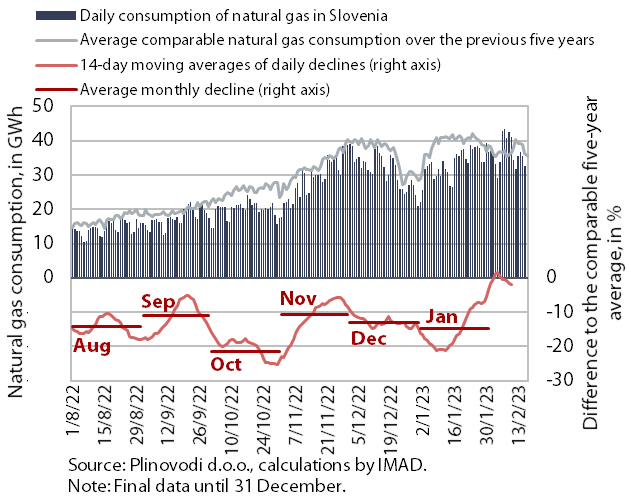
In the first half of February, when temperatures were low, gas consumption was only about one percent lower than in the same period of previous years. In addition to parts of industry adjusting to high gas prices by limiting consumption in production processes and government measures to promote more rational consumption of gas, the weather also has a significant impact on the amount of gas consumed (for example, gas consumption last October, which was record warm, was more than a fifth lower than in previous years). According to Eurostat, EU Member States reduced their gas consumption more than Slovenia between August and November, by around 20% compared to the previous five-year period (Slovenia by around 15%), which, together with the still relatively full gas storage capacities, is a positive sign that the EU will not have major gas supply problems. According to preliminary data, gas consumption in Slovenia in the period from 1 August 2022 to 17 February 2023 was 13% lower than the average consumption in the same period over the last five years, which is slightly below the EU recommendation to cut gas consumption by at least 15% from August 2022 to March 2023.
Electricity consumption by consumption group, January 2023
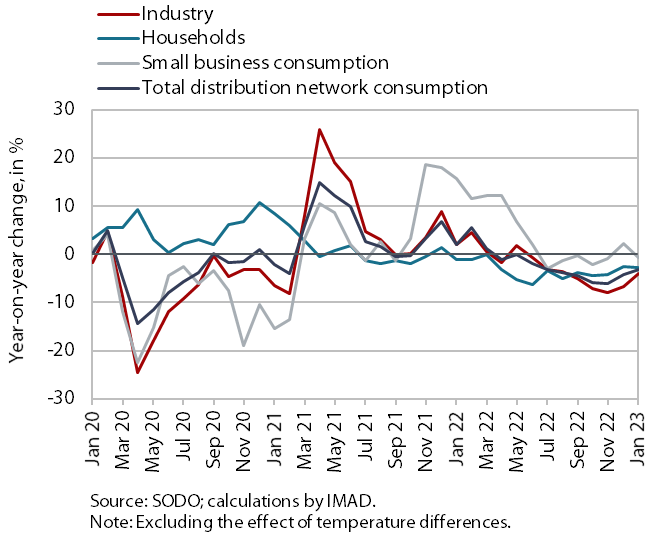
In January, electricity consumption in the distribution network was lower year-on-year in all consumption groups, as it has been for several months now. The largest decrease was seen in industrial consumption (by 4.0%), according to our estimates due to lower consumption by the energy-intensive part of the economy. Household consumption was also lower year-on-year (by 2.8%), which we estimate to be due to more rational energy consumption and also to fewer people working from home compared to the same period of 2022, when the number of COVID-19 infections surged and consequently more people were working from home, absent due to illness and sent to quarantine. In January, small business consumption was only slightly lower (by 0.7%) than a year ago.
